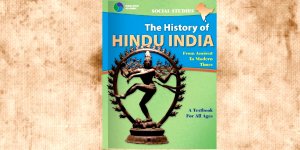| Titi Tudorancea TV / Documentaries |
Introduction to Advaita Vedanta
Part 6/6: Ishvara - The Fabric of Creation
A video presentation by Swami Tadatmananda Saraswati, Arsha Bodha Center, United States
(Tapescript) Welcome! In our previous presentation, we began an inquiry into the existence and nature of Ishvara, the first cause, the source from which the universe arose.
Instead of relying on faith alone, as Western religions do, we used the traditional teaching methodology of Vedanta that rationally and systematically explains the nature of Ishvara.
We saw how Ishvara is the efficient cause or nimitta karana, the intelligent agent who created the universe. As such, Ishvara possesses the power of creation, the creative capacity through which the universe was brought into existence.
Ishvara’s creative capacity is what we commonly call maya.
Ishvara also possesses the knowledge necessary to create a highly ordered universe that’s strictly regulated by natural laws and infused with so much intelligence that human beings can evolve here.
Having established Ishvara as the efficient cause for the universe, in this presentation, we’ll examine the second of the two causes required to make or produce anything, the material cause, upadana karana.
Let’s return to the example of the pot and potter we used before.
The nimitta karana for a pot is the potter himself, who possesses both knowledge of pots and the skill to make them. But, in addition to the potter, clay is also required, and that clay is the material cause, the upadana karana.
In the same way, even though Ishvara possesses both the knowledge and skill or power to create the universe, there’s a second factor that’s required, the material cause, like the clay needed to make a pot.
To get a fresh supply of clay, the potter can go to the river bank and dig out as much material as he needs.
But, where can Ishvara go to find suitable material with which to create the universe?
This peculiar question can be answered by turning to the Chandogya Upanishad, where the rishi Uddalaka tells his son, sadeva somya idam agra asit.
Somya - Dear son, agre - in the beginning, before the universe was created, idam asit, all that existed was, sat eva - reality alone, Ishvara alone.
Before the universe was created, only Ishvara existed. Nothing else.
So, there could be no external source for the material required to create the universe. There was no warehouse or supply of fundamental stuff, so to speak.
Here, we can see the inadequacy of the potter metaphor in describing the nature of Ishvara. Metaphors are helpful, but they all have limitations or shortcomings. If a metaphor was perfect, it wouldn’t be a metaphor at all, it would be the very thing being represented. So, at this point, we have to abandon the potter metaphor.
It’s been helpful so far, but to proceed, we’ll need to use another metaphor, one that’s found in the Mundaka Upanishad; yatha - just as, urnanabhih - a spider, srijate - spins out its web, ghrnate ca - and later consumes it.
Here, Ishvara is metaphorically represented by a spider, urnanabhi, which produces thread, urna, from its navel, nabhi.
It’s remarkable that such a tiny creature can create a web that’s so intricately woven.
In the web’s complexity, we can see evidence of the knowledge and skill possessed by the spider, the intelligent creator of the web, the nimitta karana, efficient cause.
In the same way, in the incredible complexity of the vast universe, we can see evidence of Ishvara’s knowledge and power as ITS nimitta karana.
This metaphor also shows the spider to be the upadana karana, the material cause, for the web.
Unlike the potter, the spider has no external source of material. Instead, the spider produces silk-like material for the web from its own body.
So, the spider is both the nimitta karana and the upadana karana for the web.
And this shows how Ishvara, too, is both the intelligent creator of the universe, as well as the source of the material out of which the universe is woven.
One more feature of this clever metaphor is that the spider eventually eats the strands of its web to recycle the material in its own body.
Apparently, the ancient rishis observed this for themselves, and they used it to show that Ishvara is the creator, sustainer, and destroyer of a cyclic universe, a universe that goes through cycles of manifestation and dissolution.
Like this; a spider spins out a web, maintains it, and later consumes its threads to use that material in spinning out another web.
In the same way, Ishvara creates this universe and sustains it, and then draws it back into himself, in preparation for initiating the next cycle of creation.
Thus Ishvara is the srishi karta, creator, sthiti karta, the sustainer, and the laya karta, who brings about the dissolution of the universe.
Even though the spider metaphor is extremely helpful, it’s still flawed, like all metaphors are.
Let’s see what its flaw is.
Have you ever seen a web without a spider?
Of course. Since the spider is separate from its web, which is an independent object, the spider can abandon it.
But Ishvara can never abandon the universe.
Why?
Because the universe is not separate from or independent of Ishvara.
To explain this, we’ll need another metaphor, a metaphor that can depict a creation that’s non-separate from its creator. Fortunately, Vedanta provides us with just such a metaphor. And that metaphor is based on your dreams.
Whenever you dream, you create a dream world. And the dream world you create contains all kinds of things, including people who are engaged in a variety of activities, in places, far and near.
For your dream world, you are the nimitta karana, the efficient cause. As such, you possess the knowledge, in the form of your memories, that’s the basis for everything in your dream world. In addition to this knowledge, you also possess the power to create all the people and inanimate objects that occupy your dream world.
In the same way, Ishvara possesses both the knowledge and power to create the universe as its nimitta karana, its efficient cause.
Now we can ask, “all those people and inanimate objects in your dream world, what are they made of?”
In the world around us, everything is made of matter and energy, or from a prescientific standpoint, everything here evolved from the three gunas - sattva, rajas, and tamas, - as we discussed before.
But, what about everything in your dream world? What is that made of?
Simply put, it’s made of you, it’s made of your consciousness.
The people, buildings, cars, etcetera in your dream are vrittis, mental objects, and those mental objects depend on consciousness for their existence, the very consciousness that's your fundamental nature.
So, for your dream world, your consciousness itself is the material out of which everything in the dream world is fashioned.
You are not only the creator of your dream world, you are also its material cause, its upadana karana.
And in the same way, Ishvara is not only the creator of the universe, but is also the upadana karana, the fundamental stuff because of which the universe exists, whether you call that stuff matter and energy or sattva, rajas, and tamas.
Just as your dream world is made of you, your consciousness, in the same way, every atom and particle in the universe is made of Ishvara.
This dream metaphor also shows how Ishvara is the creator, sustainer, and destroyer of the universe.
Consider this: your dream world arises from you, based on your memories. And then it continues to exist in your mind for a while, along with all the people and things that inhabit your dream world. And when you finally wake up, that dream world goes away.
Where does it go?
It returns to its source, it returns to you.
In the same way, the universe arises from Ishvara, who then sustains it with his knowledge, with his intelligence that gives order to the universe through the laws of nature, as we discussed before.
Then, at the end of the cycle of creation, the universe undergoes dissolution and returns to its source, Ishvara.
Now, we’re ready for a really important step in our inquiry. We can begin by asking, “Where is your dream world located?”
Obviously, it’s located in you, it’s located in your consciousness.
Suppose you were to dream about a deeply religious person who’s undergoing tremendous suffering, and she cries out in prayer, “O God, where are you?”
Hmm. That’s interesting. Who is she praying to?
She’s praying to you, the dreamer - the creator, sustainer, and destroyer of the world in which she lives.
And from her perspective, where are you, the dreamer, located?
Where? You’re everywhere in the dream world.
You’re present in every person and in every inanimate object as the fundamental stuff out of which they are made.
Unlike the spider’s web, which is completely separate from its creator, your dream world is utterly non-separate from you.
In the same way, the universe is utterly non-separate from its creator, Ishvara, because every particle and atom in the universe is made of Ishvara.
Based on all this, if we ask, “Where, in this vast universe, is Ishvara located?," how shall we answer?
Ishvara is everywhere. Ishvara pervades the universe as the fundamental stuff out of which it’s made.
So, just as you are present in and through your dream world, in the same way, Ishvara is present in and through the entire universe.
For this reason, we say that Ishvara is all-pervasive, sarva-vyapaka.
But, there’s a better way to understand Ishvara’s all-pervasive nature. Suppose we say, “This room is pervaded by space. Space fills the room. Space is in and through the room.”
Now, all of that is correct, but there’s another perspective that’s actually more correct.
Space not only pervades the room, but it also pervades the walls of the room and extends beyond it without boundary or limit. So, even though we can say, “Space is in the room,” it’s more accurate to say that, “The room is in space.”
That’s a huge jump in perspective, and we can apply that new perspective to better understand Ishvara.
Instead of saying, “Ishvara pervades the entire universe,” we should say instead, “The entire universe is in Ishvara.”
Let’s examine this further. As we discussed before, our universe is constantly expanding.
Expanding into what?
That’s an interesting question.
You can’t say that the universe is expanding into space, because space, time, and everything else exist only within the universe and not beyond it.
Then, how shall we answer this question?
According to the ancient rishis, the universe is expanding into Ishvara. Ishvara not only pervades the universe, but also extends beyond it.
There’s a famous hymn in the Yajur Veda, called Purusha Sukta, that says, sa bhumim vishvato vritva, atyatishtad dashangulam.
sah - he, Ishvara, vishvatah vritva - having completely pervaded, bhumim - the universe, atyatishtad - he remained beyond, beyond the universe.
How far beyond?
It’s impossible to measure distance where space itself doesn’t exist, so this verse says with great poetic irony, Ishvara extends beyond the universe by dasha angulam, ten inches.
Obviously, this isn’t meant to be taken literally. It’s a poetic way of saying that Ishvara extends beyond the universe.
This hymn shows that we have to change our perspective about Ishvara being all-pervasive. Ishvara doesn’t fill the universe like water fills a pot. Just like this room exists in limitless space, so too, this universe, as vast as it is, exists within Ishvara.
This shift of perspective has some remarkable consequences that become clear if we return to the dream metaphor.
The people walking around in your dream world are actually walking around in you. Wherever they go in your dream world, they remain within you.
In the same way, you and I are actually walking, traveling, and living out our lives within Ishvara.
Now, saying that we live in Ishvara might give someone the strange idea that we’re like amoebas or bacteria living in someone’s gut. The bacteria living in our intestines are separate from us, but we are not separate from Ishvara, because Ishvara is the very material we are made of.
We are in Ishvara, because there is only Ishvara, just as in your dream world, there is only you, consciousness.
Before moving on to the final topic in this presentation, please note that we’ve just concluded an extensive discussion about the existence and nature of Ishvara, and at no point were you ever asked to believe anything.
Nothing was based on blind faith. This is the uniqueness of Vedanta’s approach to theology.
Rather than relying on unquestioned acceptance of scripture, as the Western religions do, Vedanta carefully supports every scriptural statement with reason and rational discourse.
In Vedanta, Ishvara is not merely a matter of faith; it is a reality to be personally understood.
Now, in the last part of this presentation, we’ll briefly consider the culminating teachings of Vedanta, as expressed in the famous statement, tat tvam asi, that thou art.
Statements like this explain how we’re related both to Ishvara, and to the world around us.
This is a big and heavy topic, but we can get the gist of it by using another traditional metaphor, a metaphor that compares Ishvara to a mighty ocean.
Waves are born of the ocean, waves are sustained by the ocean as they travel across its surface, and waves eventually return to the ocean when they wash up on the shore.
In the same way, you, me, and everything else that exists in the universe are born of Ishvara, we are sustained by Ishvara, and we return to Ishvara.
In the ocean, some waves are huge - they could represent soaring mountains and wide continents. Some waves are tiny - they could represent all of us living amongst those mountains and continents.
And, these waves, large and small, all exist within the mighty ocean, just like every living being and inert object in the universe exists within Ishvara.
All this we’ve already seen, when we used the dream metaphor.
So, even though this ocean metaphor makes the same point, it’s actually intended to show something more. Here’s the idea: Every wave is made of water. In fact, a wave is only water.
The shape of the wave isn’t something separate or different. If a wave contains 100 gallons of water, the shape of the wave doesn’t add anything. So, every wave in the ocean is just a form of water.
And, the entire ocean is itself another form of water, even though it’s a much larger form.
Both ocean and waves are but forms of water, the same water.
The water because of which the mighty ocean exists is exactly the same water because of which each and every individual wave exists.
The mighty ocean and each individual wave are utterly different in form, but they are one in essence, because they are just water, and nothing else.
Can you see the striking implications of this metaphor?
It shows how Ishvara and his creation, including you and me, are one in essence, even though all our forms are utterly different.
The essence because of which Ishvara exists and the essence because of which you and I exist are one and the same.
That’s exactly what’s expressed by the statement, tat tvam asi, that thou art.
Tat -that - the essence because of which Ishvara exists, tvam asi, thou art, you are the same in essence.
This statement reveals the one absolute reality because of which Ishvara exists, the universe exists, and we exist as individual beings.
That non-dual reality is what we call brahman.
Obviously, this is an extremely brief treatment of Vedanta’s loftiest truth. But, it can help acquaint you in general with the grand vision of the ancient rishis.
And, having reached this high point in our inquiry, we now conclude this series of presentations introducing the teachings of Vedanta.
I hope these presentations have been helpful to you in supporting your process of inquiry and spiritual growth.

Subscribe now to get unrestricted access to all resources, in all languages, throughout this web site!
Subscription Form
YOU MAY ALSO LIKE







Subscribe now to get unrestricted access to all resources, in all languages, throughout this web site!
Subscription Form